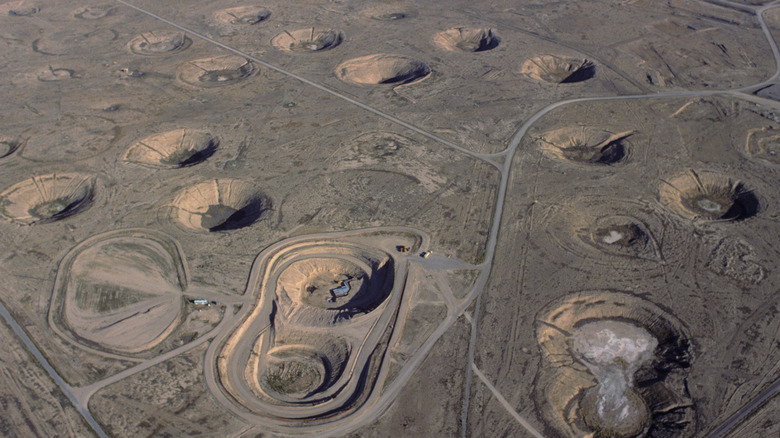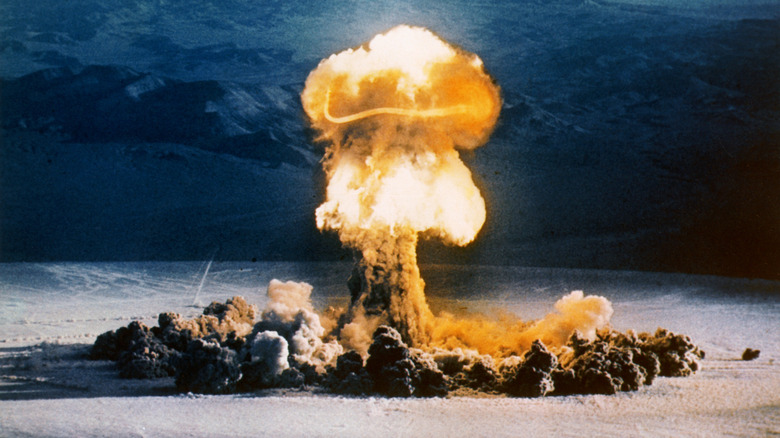Why Nevada Was Nuked More Times Than Any Other Place On Earth
On July 16, 1945, the skies of Los Alamos in New Mexico were lit by something other than the sun when, at 5:30 a.m., the first atomic bomb detonation, known as the Trinity nuclear test, ushered the world into the Atomic Age. Presented as an alternative to invasion to end the war quickly, the atomic bomb harnessed the power of the atom, unleashing the most powerful manmade destructive force and altering the balance of power in the world. From this first test, other countries followed suit, with the U.K. conducting 45 tests and the Soviet Union carrying out 715 of its own. The United States, however, has the most, completing 1,029 nuclear weapons tests, with the majority located in the Nevada desert.
Before the creation of the Nevada facility, the United States conducted nuclear weapons tests at Bikini and Enewetak Atoll in the Marshall Islands. A series of tests called Operation Crossroads and Operation Sandstone were done, and 67 tests were completed, including one where the nuclear bomb was tested against U.S. Navy ships. In 1950, President Harry S. Truman approved the establishment of the Nevada Test Site, located within the Nellis Air Force Gunnery and Bombing Range.
The main reasons why Nevada was selected as the location for nuclear weapons testing were its large, government-controlled geographic area, ideal wind patterns, and low population density. These factors allowed for relatively safer testing because fallout from atmospheric weapons tests would be carried away from large populated areas by the wind. The Nevada Test Site hosted 928 nuclear tests from 1951 to 1992, with 100 as atmospheric tests, while the rest were underground. For comparison, the Soviet Union had two major test sites, Novaya Zemlya and Semipalatinsk, with the latter conducting 456 tests.
Silent witness to nuclear power
The first nuclear test at Nevada was on January 27, 1951, when a one-kiloton device called the Shot Able was detonated. Another notable test was done on July 2, 1962, as part of the Plowshare Program, which detonated a 104-kiloton bomb, the largest device ever used in Nevada, leaving behind a crater 1,280 feet wide and 320 feet deep, enough to swallow the Statue of Liberty in its wake. By September 23, 1992, the final nuclear testing at Nevada was carried out underground using the Divider nuclear device.
Initially testing atomic bombs, which are also nuclear weapons, above ground or in the atmosphere, the Nevada Test Site held its first contained underground test in 1957 with the Rainier test, which later contributed to the start of peaceful nuclear explosions tests. The objectives of Nevada's nuclear weapons testing were to teach scientists and the military to develop and improve nuclear weapons, review the long-term effects, and assess the efficiency and power of nuclear armaments. Additionally, it helped advance nuclear energy production by providing important insights into nuclear processes and material behavior, and disposal, which were subsequently used in civilian nuclear power.
The tests in Nevada have left behind a complex legacy. It helped advance science and technology, but the lingering impact of the tests on the environment and the negative health effects it caused remain a point of concern that is still being studied and addressed today. After witnessing the destructive capability of nuclear weapons, many nations have agreed to programs and treaties to safeguard and limit their use and proliferation. In addition, recycling spent nuclear fuel has been implemented by many countries, further mitigating the negative impact of nuclear power.

